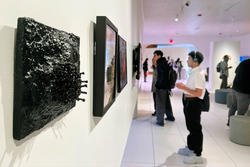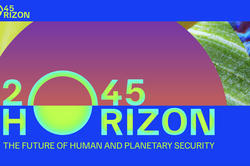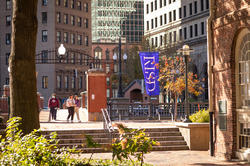An ongoing initiative brings together experts and futurists from around the world to consider planetary policy decisions that increase the odds of our survival.
RISD’s Center for Complexity Presents Exhibition Addressing the Threats of a Human-Centric World

This fall, the Center for Complexity (CfC) curated Gateways into the Polycene, an exhibition on view in 20 Washington Place that challenges staff and faculty members to consider creative alternatives to a human-centric society that would enable a more just, sustainable and plural future—dubbed “the polycene.” The work addresses the overlapping and interconnected threats—or polycrises—to current society, such as the pandemic, climate change and population increase.
The responses to the call for proposals were wide ranging and complex. Associate Professor Lisi Raskin, who teaches in the Sculpture department, submitted Cry Hiking, a film that considers relationality and power dynamics between humans and non-humans. Assistant Professor Leah Beeferman, who teaches first-year students, contributed digitally sculpted satellite images that address the relationship between humans and the climate.
“In this exhibition, we’re weaving together our research interests, our partners and our community into a kind of enterprise,” says CfC Executive Director Justin Cook. “The show is about asking questions, showing alternatives and developing different aesthetics. It’s not yet pointing a way forward, but rather giving us a sense of the landscape.”
Among the artists in the exhibition were Teaching and Learning in Art and Design faculty member Lilly Manycolors MA 22 GAC and Assistant Professor Stephanie Choi, who teaches in Architecture. Manycolors’ piece, Las Máscaras son Portales//PLANETATION, explores the concept of using masks to practice empathy during the shift into the polycene. Choi’s animated projection, Twilight Requiem, confronts the space of passage between the living and the dead through an Asian futurist vision of new rituals created in response to climate change.


RISD Museum night watchman VF Wolf 18 PT, whose practice draws on his early adult life experience in the military, also entered work into the exhibition. “Through my art I wish to analyze the shadow and darkness present in every society,” says Wolf. “I feel in many ways my work addresses the absurd and random nature of life itself.”
Wolf created a mixed-media triptych titled Mothership, which addresses the beginning of mankind as a whole, emphasizing our similarities over our differences. “I wanted to create a piece that would act as a reminder to the viewer of our shared prehistoric past,” explains the artist. “One section symbolizes all mankind on Earth as one life force pulsating with rhythmic energy, while the last panel demonstrates that we are our strongest when all humans on Earth share ideas and become one.”
Associate Professor Tyanna Buie, who teaches Printmaking, submitted three films, which were projected back to back on a TV screen in the exhibition. In the films Self-Help, Inner-Views and Of the Future, Buie’s face appears on various famous people’s figures in clips taken from significant Black cultural moments. “I like the idea of edutainment,” says Buie, “where entertainment and education come together so the viewer is learning about things while being entertained.”
The three films address the topics of Afrofuturism, artificial intelligence, Black feminism and more. “I’m bleeding it all together in a very collaged and organic way,” says Buie. “I love the idea of pop culture being an equalizer— it’s a beautiful merging of everyone coming together. It’s funny, but it has a serious tone as well.”

“If we have the opportunity to work across our silos and think together about these issues, we can make some really powerful discoveries.”
Industrial Design faculty member Megan Valanidas MID 18, whose work commonly addresses such themes as soil, futures, ecology and convenience, contributed a diorama to the exhibition called The Green Beyond: Expanding and Preserving Our Wild Spaces. “I find the diorama to be a very accessible way to portray a snapshot of a world,” explains Valanidas. The piece speaks to human burial practices and their effect on the planet.
For Valanidas, assembling the piece was just as important as the final product. In the beginning stages, she created small figures that she then buried in soil at the bottom of a terrarium. “Having part of the work covered with soil made it really difficult to view these tiny, interred bodies,” she says. “I included a mirror at the base of the piece, allowing the viewer an underside view of the buried bodies.”
All of the artists, including Experimental and Foundation Studies faculty member Griffin Smith and Hyundai Research Collaborative project manager Miguel Lastra MFA 22 CR, delivered talks about their work in a fall lecture series. “We’re all part of this incredible creative community,” says Cook, “and if we have the opportunity to work across our silos and think together about these issues, we can make some really powerful discoveries. This exhibition is evidence of that.”
Isabel Roberts / top image work by Griffin Smith
October 10, 2023


